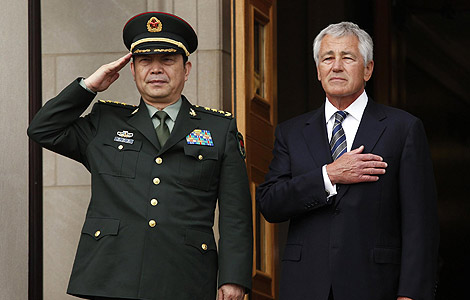US, China both matter for Asia
Updated: 2013-08-20 07:53
By Edward Lee (China Daily)
|
||||||||
China's influence over Asia is significant today and growing. But it is by no means the only story in Asia. Perhaps because of China's stellar rise, it is easy to overlook the substantial sway the United States economy still holds over much of Asia.
Concerns over the slower growth trend in China, along with the specter of the US Federal Reserve Board's "tapering" of quantitative easing (QE), has spooked global financial markets in recent months. On the positive side, though, China's government is sticking close to its strategy of ensuring balanced and sustainable growth, and the US economy, helped by gains in the housing and labor markets, is recovering.
China's slowdown is likely to result in some moderation in Asia's near-term growth. But any such short-term sacrifice should benefit China and the rest of the region both in the longer term. Such an outcome would be much more palatable than unabated over-investment in China, which could prove unsustainable and costly for the regional as well as the global economy.
Over-emphasizing the slowdown in China's growth trend risks neglecting the mitigating effect of the US recovery. The US is still the world's largest economy, almost twice the size of China's in terms of nominal gross domestic output. Because of this, it is timely to assess the relative influence of China and the US on various countries in Asia. Which Asian economies are more exposed to the US and which are more reliant on Chinese demand for growth?
In a recent study, we (Standard Chartered Bank) examined these linkages through overall growth and the channels of trade, tourism and foreign direct investment. We found that Northeast Asia and Singapore are more exposed to China than to the US, while India, the Philippines and Indonesia lie at the other end of the spectrum. Note that this does not mean India is as exposed to the US as Hong Kong is to the Chinese mainland. This is a relative ranking.
Our study shows that, in the past five years, China's importance to Asia has grown relative to the US. Over a longer period, though, Asia is more exposed to US headline growth than to China's. It is vital for Asia that any slowdown in China be moderate and gradual so that economies can adjust without suffering too much volatility.
The trade route underlines this point. Asia is a highly open region. Of the 10 economies we studied in the region, six have trade exceeding their total domestic economic output. Trade is a clear channel where China shows its dominance in Asia. This has been particularly true in recent years - all 10 economies in our study have increased their exports to China relative to the US since 2005. The increases were the most obvious in Hong Kong, Taiwan, Australia and the Republic of Korea.
As of 2012, only the Philippines and India exported more goods to the US than to China; the other eight economies exported more of their products to China. Back in 2005, only three economies exported more goods to China than to the US. However, this analysis does not take into account the indirect trade exposure of each economy to the US. A significant portion of the region's exports is re-exported by China to the US and other Western markets.
Tourism also links Asian economies together and influences regional growth. Tourism accounts for 2-8 percent of GDP for the economies we studied. Given its proximity, China is the dominant source of overseas tourists for most of Asia, with the exception of India and the Philippines. Within Asia, Hong Kong, Taiwan and the ROK receive the largest number of Chinese mainland tourists as a share of their total tourist arrivals. All 10 economies have seen a widening gap between the number of Chinese mainland and US tourist arrivals since 2005. And Chinese mainland tourists spend as much as their American counterparts (on a per capita basis) in some places.
Foreign direct investment is another important channel through which the US and China influence growth in Asia. With the exception of Hong Kong, where the Chinese mainland has made significant investments, the US remains the dominant investor in Asia.
We expect US economic growth to accelerate to 2.7 percent in 2014 from 1.6 percent this year, and China's growth to ease to 7.2 percent from 7.5 percent. Taking into account these forecasts, our study concluded that the net growth impact of a mild slowdown in China and a recovery in the US will be positive for economies such as Malaysia, Singapore and the ROK, and Taiwan and Hong Kong, all else being equal.
The importance of China to the health of the global (and Asian) economy is undeniable. But as long as China's much-needed rebalancing is moderate and well calibrated, and US growth continues to show a reasonable improvement, Asia will stand to gain in both the short and long term.
The author is regional head of research for Southeast Asia at Standard Chartered Bank.
(China Daily 08/20/2013 page9)

 US, China to expand military exchanges
US, China to expand military exchanges
 Snowden reporter to publish UK secrets
Snowden reporter to publish UK secrets
 PLA aerobatic team to perform in Russia
PLA aerobatic team to perform in Russia
 Poetry with power
Poetry with power
 A game Chinese hoopsters are bound to lose
A game Chinese hoopsters are bound to lose
 Wild Africa: The new attraction to Chinese tourists
Wild Africa: The new attraction to Chinese tourists
 Peng Shuai, Hsieh Su-wei win Cincinnati title
Peng Shuai, Hsieh Su-wei win Cincinnati title
 Ride to fly on the top of mountains
Ride to fly on the top of mountains
Most Viewed
Editor's Picks

|

|

|

|

|

|
Today's Top News
Western program new engine for growth
China, Kenya agree to bolster ties
Online shopping clicking up
Typhoon wreaks havoc in the south
ROK-US drill starts as tensions ease with DPRK
Manners missing in overseas travel
Snowden reporter threaten UK
Egypt's Mubarak may be freed
US Weekly

|

|







